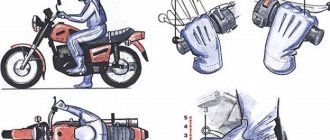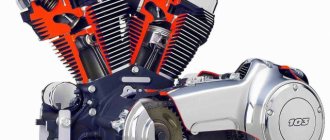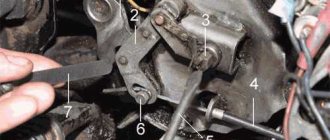Hi all! Many people want to get behind the wheel of a car and enjoy the benefits of a personal car. But before you do this, you have to go through a difficult learning curve. Practice clearly shows that the main problems arise with how to change gears correctly and with mechanics.
Initially, the most difficult thing for a beginner seems to be simply learning how to get going. But in just a few practical sessions this point can be mastered until it becomes automatic.
But switching to a manual transmission while driving is more difficult. This is a gradual process of developing a reflex that allows you to move from one speed to another in a timely manner and without being distracted by the lever itself, almost at the level of intuition.
The key rule is to always use the clutch pedal. In theory, you can learn to shift without a clutch, but then the box won’t last long and will have to be replaced soon. Therefore, when braking and accelerating, the clutch pedal and gearshift lever must work in tandem.
Important nuances
Ideally, the car should drive without jerking, moving from one speed to another. When buying a used car or a new car, all buyers always look at such a detail as the type of gearbox used. Objectively, the easiest car to drive is considered to be an automatic transmission. But it is important to understand that there are a number of types of gearboxes, and not a simple division into manual and automatic. We recently studied with you the features of sequential gearboxes, and also got to know the variator in more detail. I advise you to re-read and update your own knowledge regarding automobile gearboxes. In terms of reliability and durability, classical mechanics still firmly holds the first position.
When used correctly, the car can accelerate quite quickly, squeezing the maximum out of the installed engine. But when the engine is powerful, and the driver does not know how to shift correctly, then no amount of horsepower will help you.
One general principle applies to all manual transmissions. It consists in the fact that first the clutch is depressed, then the speed is switched, after which the clutch pedal is lowered.
Peregazovka
Here, the meaning of the throttle change itself from a technical point of view remains the same; you need to equalize the rotation speeds of the shafts, crankshaft and gearbox output shaft. For example:
- 1. We are driving in fourth gear.
- 2. Release the accelerator (gas) pedal.
- 3. Depress the clutch and shift to second gear.
- 4. Keep the clutch pressed, then press the gas pedal, thereby increasing the engine speed.
Here it is worth paying attention to the following: depending on the same engine (gasoline or diesel), on the volume, power and weight of the pistons, as well as on other combined factors, the speed of increase in speed will be different. In some places you need to press the gas for much less than 1 second, in others you need to hold the gas (accelerator) pedal a little longer.
- 5. Having raised the engine speed by about a quarter or a third (again, everything depends on many factors, practical training will be required to understand the optimal increase in speed) and without going into the red zone of the tachometer, quickly and smoothly release the clutch pedal.
See also: How to drive a manual: Ten simple steps
It will instantly become much easier for the car engine to turn the transmission and the car will receive the necessary acceleration. Everything is simple, nothing supernatural.
This is how things are, our dear car enthusiasts. Now we hope you understand how to do this, now the last thing left is to learn everything in practice. Good luck to you!
When to switch
Switching should be smooth, but at the same time fast.
Many are rightly interested in when exactly it is necessary to switch from one speed to another. Although there are different cars and boxes, there are averages. Namely:
- The first speed is intended mainly for starting, and is not used for active driving. The current speed here is from 0 to 20 kilometers per hour;
- The second speed is accelerating and is used for movement at low speed in the range from 20 to 40 kilometers;
- The driver must switch to third when he needs to accelerate from 40 to 60 kilometers per hour;
- The fourth is suitable for speeds from 60 to 80 kilometers per hour;
- Fifth and sixth speed for driving over 80 kilometers per hour.
These numbers are approximate and average, as there are a number of other factors that affect driving.
The presented diagram is relevant for cars that are not loaded and move along the road without resistance in the form of sand, deep snow or steep inclines. If there is such resistance, then it is recommended to switch to the next gear a little later.
Motorists and driving instructors have developed a useful reminder that they recommend that a beginner remember. The bottom line is this:
- It is always recommended to use first gear solely for starting;
- After the start, you should immediately turn on second speed;
- Second gear serves as acceleration speed on a manual transmission;
- The third is optimal when overtaking;
- The fourth performs best when driving in urban conditions;
- The fifth and sixth are used for expressways, highways and highways.
You can also shift out of order if necessary, shifting from high to low to apply engine braking.
There are a number of visual videos on the Internet about how to properly operate the gearshift lever on a manual car. Both high and low gears are discussed in detail.
How to change gears.
In this lesson you will learn
How to select gears Logic of using gears Speed ranges of each gear Using a tachometer What to use a speedometer or tachometer Techniques for working with gearbox Exercise “Clutch – Gearbox lever – Gas” Features when accelerating a car Exercise “Accelerating a car with gear shift 1-2-3-4″ Recommendations Typical mistakes Shifting gears, from up to down Gear selection Recommendations for driving on descents and ascents
How to choose gears.
To learn how to choose gears correctly, you need to stop calling gears in a gearbox (gearbox) speeds (km), since this conceptual error sometimes complicates the understanding of this process.
A common question for a novice driver is how to change gears? It sounds incorrect because they change gears (gears), not speeds (km).
Next, you need to:
• understand the logic of using gears; • study the speed ranges of each gear; • learn the nuances of using gears in various road conditions.
Study all this in detail and of course practice.
Now, let's take a closer look.
Logic for using gears.
So, we figured out the concepts of gears (gear) and speed (km). Now, I will try to explain the simple sequence of gear selection.
All novice drivers know that gears are selected depending on the speed of the car. The logic is simple (speed > gear), but this sequence is missing the main thing. How to choose the speed?
Novice drivers choose the speed as they were taught at school according to the rules and road signs, but it is better to make allowances for the road situation and weather conditions. Because the maximum permitted speed will not always be safe for you and others.
Therefore, the best logic for selecting speed and gear is: Road situation + weather > selecting a safe speed > selecting a gear.
You can read more about choosing speed in various road and weather conditions in other articles on the site.
Now, you should find out and study the speed ranges of each gear.
Speed ranges for each gear.
The minimum and maximum speeds in each gear are usually indicated in the operating instructions for your vehicle.
And now, I will give the average values of gear speed ranges for cars with a gasoline engine.
Gearbox Speedometer km/h gear Speed range min-max. 1st gear 0 - 40 2nd gear 20 - 60 3rd gear 40 - 80 4th gear 60 - 100 5th gear 80 - max. It is important to adhere to these average speed ranges so as not to create unnecessary overloads for the vehicle’s engine and transmission.
Using a tachometer.
Tachometer is a device that shows the speed of the engine crankshaft in revolutions per minute.
When accelerating to maximum speed in each gear, it is better to use the tachometer to determine the maximum engine speed, so as not to overclock the engine speed into the red zone of the scale. Do not allow the engine to operate at high speeds in the red zone of the tachometer scale, this can lead to engine damage and expensive repairs.
It is convenient to use the tachometer to change gears.
1. Minimum engine speed 800-1000 rpm. In this mode, the engine can only operate at idle speed (without load).
2. The start of movement from a standstill on a horizontal section occurs at low crankshaft speeds: 1,500-2,000 rpm.
3. The optimal range of engine crankshaft speeds during acceleration for changing gears and climbing is 3,000-3,500 rpm.
4. For intensive acceleration, you can “spin” the engine further - up to 4,500-5,000 rpm, but it is not recommended to “put” the instrument needle in the red zone of the scale.
Attention! The minimum and maximum driving speeds for each gear are usually specified in the vehicle's operating instructions.
What to use speedometer or tachometer.
You can change gears using both the speedometer and tachometer readings. You just need to choose the acceleration rate, that is, minimum, average or maximum, depending on road and weather conditions.
For example, the rate of acceleration and gear shifting according to the tachometer:
Minimum 2000-2500 rpm - used when the car is moving calmly and economically on horizontal sections without hills, as well as on snowy and icy roads.
Average 3000-3500 rpm - used when driving in the city and in the countryside, and is also the minimum acceleration of the car when driving uphill.
Maximum 4500 - up to the yellow zone rpm - used, as a rule, when overtaking, accelerating uphill in a loaded car, and active dynamic driving.
Thus, depending on the traffic situation and weather, you choose the acceleration pace and adapt to the general pace of the traffic. Typically, in dry weather, the pace changes frequently depending on the traffic congestion, and in wet, snowy and frosty weather, as a rule, the pace of movement is uniform.
The table discusses gear shifting points for cars with a gasoline engine, using a speedometer or tachometer to choose from.
Speedometer Speedometer Speedometer Acceleration tempo Minimum km/h Average km/h Maximum km/h Tachometer rev. 2000-2500 3000-3500 4500-to the yellow zone gearbox gear 1st gear 0 20 2nd gear 30 40 3rd gear 40 50 60 4th gear 60 70 80 5th gear 80 90 100
Techniques for working with CP.
Gear lever grip
To move it, it is recommended to take the lever with your right hand with a closed grip. This method ensures fast and accurate switching. In this case, when the lever is pulled towards you, the fingers pull it, and the palm controls its position. When moving away from you, the palm presses on the handle, and the fingers control the position of the lever.
Attention! In the “N (neutral)” position, the lever is in a position between 3-4 gears.
When shifting, it is important not to apply a lot of force to the lever.
You should not look at the gear lever, your gaze should be directed forward, and your left hand should be on the steering wheel.
It is very important to develop the student’s skills in controlling levers and pedals and the necessary sequence of actions when working with them.
Gearbox control lever.
Operated with the right hand. The main position of the lever is neutral. Depending on driving conditions, the driver selects gears 1-2-3-4. Switching on is done by moving the lever in accordance with the diagram specified in the vehicle’s operating instructions.
Gear changes are made only when the clutch pedal is pressed. Otherwise, the gearbox may be damaged. They change gears calmly without sudden movements.
To interact with the clutch pedal, gas pedal and shift lever, you need to practice the following exercise with the engine not running.
Exercise 5. “Clutch – Gearbox lever – Gas”
1. Press the clutch all the way to the floor (times ). 2. Engage 1st gear and lightly add gas (two). 3. Smoothly release the clutch, press the gas slightly (three - four - five). 4. Press the clutch and simultaneously release the gas (one time). 5. Engage 2nd gear and lightly add gas (two). 6. Smoothly release the clutch, press the gas slightly (three - four - five). and so on.
Shift gears in order up 1-2-3-4 and down 4-3-2-1.
When switching from 1st to 2nd, it is not necessary to move the lever to the neutral position; it is enough to move it in a straight line all the way back.
Features when accelerating a car.
Under normal road conditions, you should not drive for a long time in first gear, as this causes unnecessary excess fuel consumption. Therefore, after starting to move, it is necessary to increase the speed of movement and shift gears from low to high gear.
When accelerating, do not delay driving in lower gears. The vehicle speed in each gear should gradually increase to the required values.
In the future, if conditions and traffic safety allow, the car should be driven in top gear. However, in some cases it is recommended to use only first gear for driving in difficult road conditions: on rough roads, off-road, when driving up a steep slope, that is, where a speed of up to 20 km/h is required.
The driver chooses the speed depending on the driving conditions, so it is necessary to practice shifting gears, both in ascending and descending order.
Attention! When changing gears or turning on equipment and other cases, the car is controlled with one hand, so at the initial stage of training you should strictly control the trajectory of movement.
Exercise »Accelerating a car with gear shift 1-2-3-4″
Starting the car moving from a standstill.
1. Accelerate the car to 30 km/h (add gas). 2. Simultaneously press the clutch and release the gas. 3. Shift from 1st to 2nd gear. 4. Add low throttle and smoothly release the clutch. 5. Accelerate the car to 50 km/h (add gas). 6. Simultaneously press the clutch and release the gas. 7. Shift from 2nd to 3rd gear. 8. Add low throttle and smoothly release the clutch. 9. Accelerate the car to 70 km/h (add gas). 10. Simultaneously press the clutch and release the gas. 11. Shift from 3rd to 4th gear.
Regulate the gas speed (80 km/h).
Attention! Releasing the clutch pedal should be done by bending the knee and hip and not, in any case, by flexing the foot joint. The heel of the foot should not touch the floor when pressing and releasing the pedal.
When releasing the clutch pedal, you need to slightly hold the clutch pedal for 1 second. (at the moment of connecting the clutch discs) in the same place where we hold the pedal when starting off. This is necessary so that the car can continue to move smoothly without jerking in the next gear and only then smoothly release the clutch pedal.
Next, remove your foot from the pedal and place it on a special footrest to the left of the pedal.
Recommendations:
• practice car acceleration when changing gears over a short distance (25-30m);
• use first gear only to start the car;
• when changing gears, operate the clutch and gas pedals as if starting from a stop;
• change gears smoothly.
Typical mistakes:
• insufficient acceleration of the car, • low throttle is not increased after changing gears.
Shifting to higher gears must be done sequentially only after the vehicle has accelerated. If the speed is insufficient, the engine will “respond” to upshifting by jerking, reducing speed, and sometimes stopping.
Do not drive in higher gears at low engine speeds.
It is very important to learn how to change gears to higher ones and back in a timely manner.
Attention! You don't have to keep your foot on the clutch pedal all the time. This leads to unnecessary stress and fatigue on the leg, and premature wear of the clutch.
Pay attention to the complete disengagement of the clutch when changing gears, for which the pedal should be pressed all the way.
When the gears are engaged, the clutch releases smoothly. The required gear must be engaged before turning.
Shifting gears, from high to low.
1. Use the brake pedal to reduce the vehicle speed to the speed range of the selected low gear.
2. When the car reaches the speed range of the selected low gear, stop braking and press the clutch pedal.
3. Engage the selected gear and press the gas pedal (1500-2000 rpm).
4. Release the clutch pedal smoothly all the way.
If, when driving in higher gears, you have to reduce speed, for example, due to changing driving conditions, then the engine power will not be enough, the car will begin to move jerkily, and its speed will quickly drop.
In this case, you need to switch to a lower gear. Each gear has its own lower speed limit, upon reaching which it is necessary to switch from this gear to a lower one.
It is necessary to select a gear based on the specific driving conditions of the vehicle.
The first gear is intended for starting from a stop, moving around the yard or country road, and overcoming a steep climb. Also, in first gear, drivers usually “crawl” in traffic jams.
The second and third gears are used when driving relatively slowly along city streets and alleys, on gentler slopes; in addition, these gears are used (switched) during maneuvers that are impossible at high speed: turns, entrances to adjacent territories, etc.
The fourth gear is designed for driving at a fairly high speed on open streets, avenues, and country roads with slight inclines.
It is recommended to engage fifth gear only on suburban highways: it will not provide your car with a higher speed than fourth gear, but it will allow you to drive quickly in a more economical mode, consuming less fuel.
Recommendations for driving on descents and ascents
1. When driving uphill, it is necessary to take into account the vehicle load and the slope of the road.
2. When driving uphill, when additional resistance forces act on the car, to change gears, you must select the upper limit of the specified speed range. On descents, on the contrary, choose the lower limit.
3. Shocks and jerks that appear in the transmission indicate the need to switch to a lower gear.
In other cases, late gear shifting leads to engine overload.
For your safety and confidence while driving! Sergey Savchenko
PS You can learn more about the secrets of driving mastery, as well as about the technique and tactics of driving a car from the book “Driving a Car.” more details
Switching process
When driving straight and during a turn, the driver needs to change the current speed set on the mechanics.
This is done according to a certain algorithm, which can be represented as follows:
- With a tight movement, the clutch pedal is pressed to the floor with the left foot;
- At the same time, you must release your foot from the gas pedal;
- smoothly but quickly select the desired gear on the box;
- when passing the lever, you first return to neutral, and then to the required speed;
- then the clutch is released;
- at the same time, work begins with the gas pedal so as not to lose speed and revolutions;
- After the clutch is fully released, good gas is added.
There are no strict and rigid restrictions in terms of the sequence of transitions at speed. Nobody forces you to shift in a strictly specified order, from 1st to the last gear.
But if you skip speeds, then you will have to spend more time accelerating and the speed will begin to drop.
About mechanics and automatic machines
Despite the fact that automatic transmissions have ceased to be a curiosity for our fellow citizens, traditional mechanics are still popular and widespread. To avoid having to spend money on a new gearbox, it is important to understand the basic rules and techniques for smooth gear shifting.
The mechanics are designed to smoothly and evenly distribute the torque produced by the engine. A manual transmission, which is commonly called mechanical, usually includes from 4 to 6 different gears, but most often on modern cars there are 5. This is not counting the reverse speed, which is also called reverse. It is the clutch that is the connecting element between the engine and the gearbox. In engagement with the crankshaft, which constantly rotates, is the gearbox input shaft. It is the clutch that allows these units to be separated and connected again without jerking.
Inexpensive but effective disinfection of car air conditioning
The mistake of beginners is usually standard, and it lies in the inconsistent action of the manual lever and the clutch pedal. As a result, the car loses speed and sometimes stalls.
Motorists who have only recently gotten behind the wheel are often easily identified not only by the U icon on the glass, but also by absent-minded and abrupt switching.
When the car starts moving, inexperienced drivers regularly release the clutch early. As a result, the car jerks, and the transmission itself gradually fails.
Considering the speed ranges relevant for shifting gears, many believe that when the car is not traveling more than 40 km/h, there is no need to switch from 2nd to 3rd gear. But remember that a higher gear does not necessarily require an increase in speed. You can safely push the third, but at the same time drive the 40 kilometers set by the limit sign.
A higher gear only allows you to go faster. That is, when choosing speed 3, it will be easier for you to accelerate from 40 to 80-100 kilometers per hour, it will take less time and the engine will behave better than when accelerating from speed 2. Having the ability to speed up does not obligate you to speed up.
XNewBalance › Blog › Shifting gears
First, we will explain what a gas booster is and why it is needed. Imagine that you are driving 60 km per hour, 5th gear, don’t rush anywhere... Suddenly a fancy Sky with a neon tint flies up to you from the left and starts honking and accelerating. Of course, your action is to move on and I’m not in a hurry. But suppose you decide to answer the “challenge”. You need to shift from 5th gear to 2nd gear. If you simply depress the clutch, engage 2nd gear, and release the clutch, the car will jerk very strongly, and the clutch will not have a good time with the gearbox. Why is this happening?
This is where we move on to the heal & toe technique. We scoured the Ru-Net for a long time, but we never found a translation (which is not surprising when instructors from advanced driving schools don’t know what it is and what it comes with), if anyone knows, please tell me. In English, heal and toe translates as “heel and toe,” which is directly related to how this technique is performed. There are different modifications of the names - heal'n'toe, heal-toe, hnt, etc.
How to shift manually without synchronizers
Synchronizers are special mechanical devices that are needed to equalize gear speeds . Without them, switching on is carried out with a crunch and difficulty. In addition, this destroys the transmission, so when turning on the gears, you need to use two techniques - double squeezing and re-throttle.
Double squeeze is used when upshifting.
The essence of this action is as follows: the car accelerates, and then you need to squeeze the clutch and switch to neutral, now release and press again and switch to the highest gear. Of course, this needs to be done as quickly as possible. Re-throttle is an old but true way to keep the transmission alive and one way to avoid losing power when downshifting. It will also be useful for those who use a manual transmission with synchronizers, since when overtaking this will help raise the speed and increase power. Many people have probably seen how a truck driver very often raises the engine speed when slowing down and does this for good reason.
When slowing down or before overtaking, you must depress the clutch, engage neutral, release the pedal and press the gas all the way. The speed will rise and at this moment you need to turn it down. In this situation, the clutch can be dropped. It’s easy to learn these techniques, just practice a little on an empty road, and then you will be able to master the technique of shifting on a manual transmission.
How to shift when overtaking
Everything here is also quite simple, but you need to know one important detail. By driving in higher gear, you can accelerate to higher speeds, saving fuel, but in a longer period of time. Time plays an important role when overtaking, because the longer it takes, the more dangerous the maneuver becomes, so it is recommended to switch the gear down and overtake the car at higher speeds. At the end of the maneuver, you can switch to the next speed. The last stage is braking . It is quite difficult to learn this, but it is quite possible. If you need to slow down very quickly, then quickly press the clutch and brake. This technique can only be used in emergency cases. For everyone else, you need to let off the gas and apply the brake. As soon as the speed drops to the next gear, depress the clutch without releasing pressure on the brake and engage a lower gear. You now need to release the clutch in the same way as when starting to move. Once you shift into 2nd gear, further braking can be done using the clutch.
Causes of automatic transmission problems and how to fix them
Hi all! Please tell me what happened to my automatic transmission in the Toyota Istima Emina Diesel 2.2 Turbo. Everything was okay, when it started knocking at idle in the donut area. I took it apart and the fastening of the donut disk broke. I set it up and it doesn't go forward or backward. If you accelerate at 3000-3800 rpm, it will go forward until you let off the gas, but it will go backwards. I am waiting!
Hello. I have a Toyota Previa 2007, after replacing the left upper airbag, a terrible grinding noise appeared when driving in reverse. There is no grinding noise at idle speed, but it appears when the speed increases. As a result, I changed all the pillows, but the grinding noise did not go away. What else could it be?











